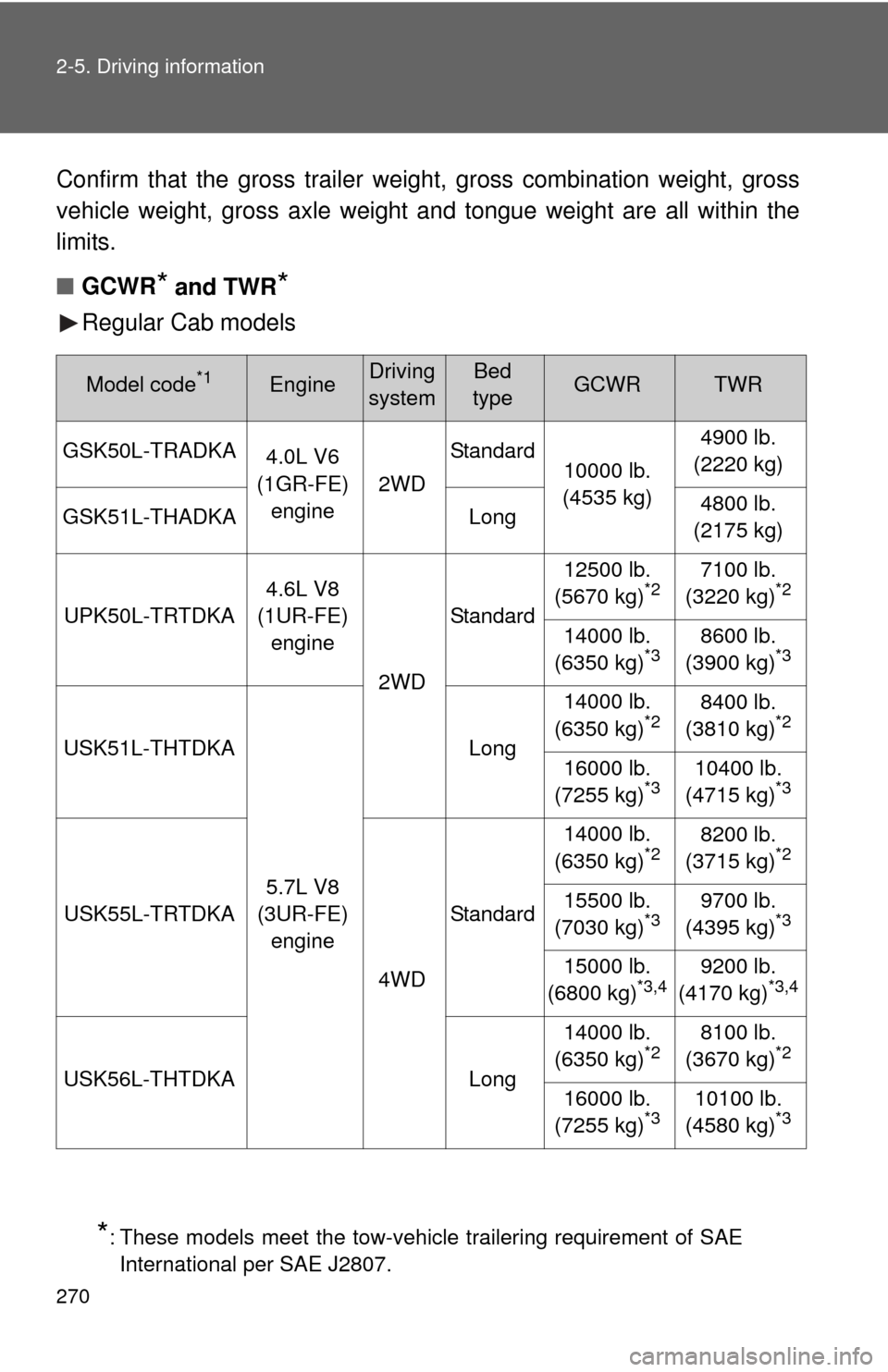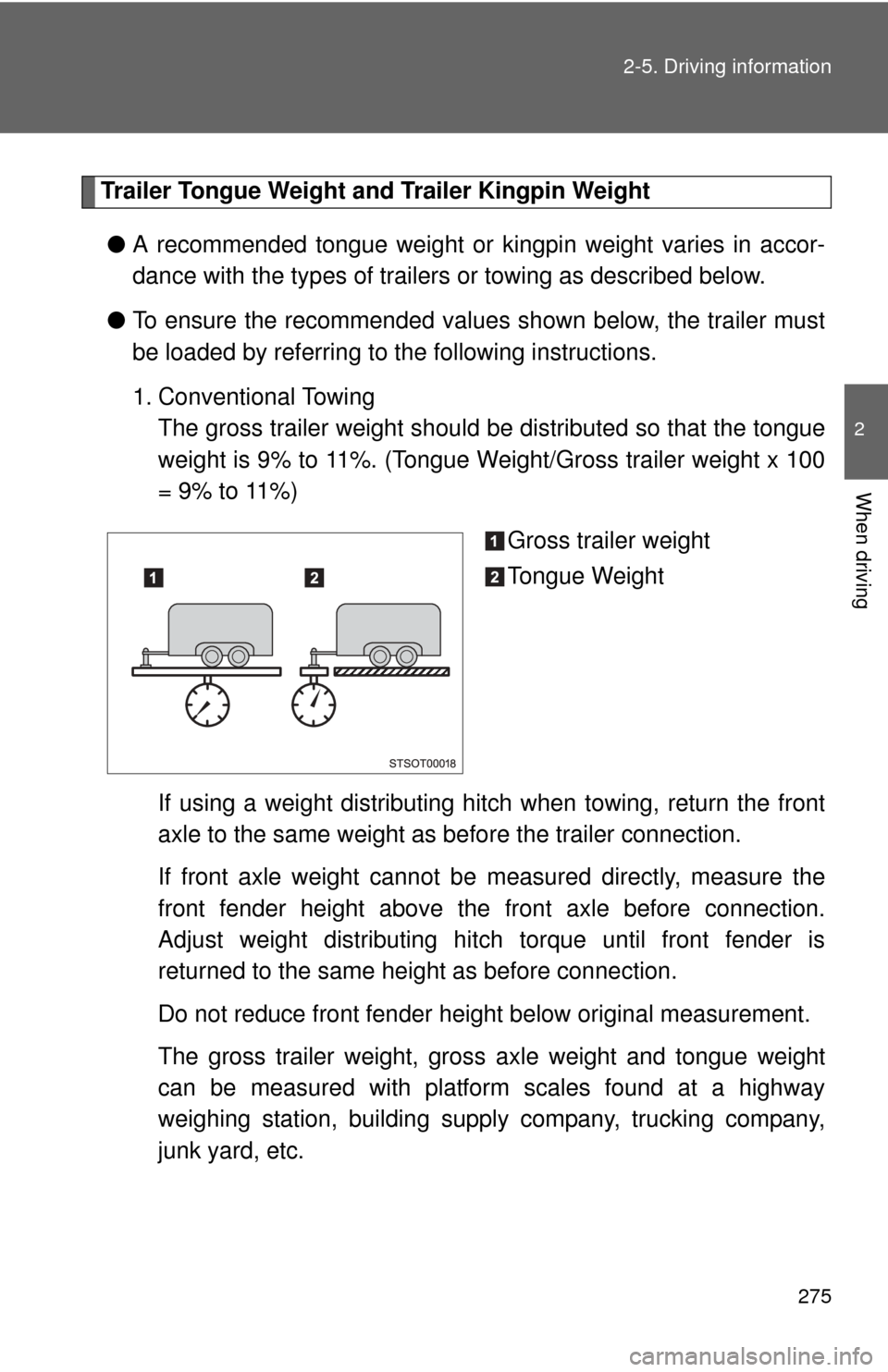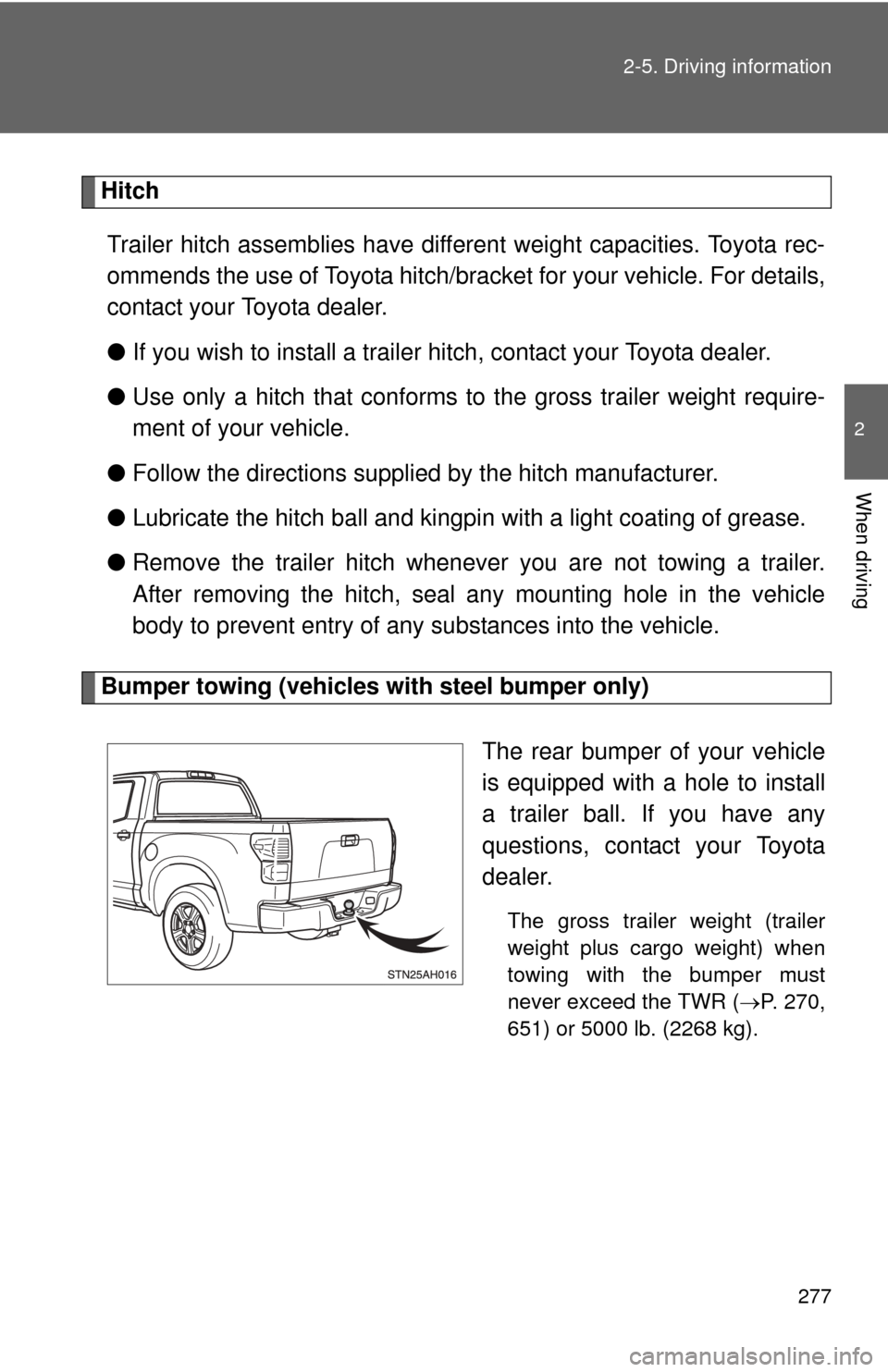Page 268 of 732
268 2-5. Driving information
■Unbraked TWR (Unbraked Trailer Weight Rating)
The trailer weight rating for tow-
ing a trailer without a trailer ser-
vice brake system.
■ Tongue Weight
The load placed on the trailer
hitch ball. (P. 275)
■ Kingpin Weight
The load placed on the 5th wheel
mount or the gooseneck ball.
( P. 275)
(Without brakes)
Page 269 of 732
269
2-5. Driving information
2
When driving
Weight limits
● The gross trailer weight must never exceed the TWR described in
the table. ( P. 270, 651)
● The gross combination weight must never exceed the GCWR
described in the table. ( P. 270)
●The gross vehicle weight must
never exceed the GVWR indi-
cated on the Certification
Label.
● The gross axle weight on each
axle must never exceed the
GAWR indicated on the Certi-
fication Label.
● If the gross trailer weight is over the unbraked TWR, trailer service
brakes are required.
● If the gross trailer weight is over 2000 lb. (907 kg), a sway control
device with sufficient capacity is required.
● If the gross trailer weight is over 5000 lb. (2268 kg), a weight dis-
tributing hitch with sufficient capacity is required.
Page 270 of 732

270 2-5. Driving information
Confirm that the gross trailer weight, gross combination weight, gross
vehicle weight, gross axle weight and tongue weight are all within the
limits.
■GCWR
* and TWR*
Regular Cab models
*: These models meet the tow-vehicle trailering requirement of SAE
International per SAE J2807.
Model code*1EngineDriving
systemBed
typeGCWRTWR
GSK50L-TRADKA 4.0L V6
(1GR-FE) engine 2WDStandard
10000 lb.
(4535 kg) 4900 lb.
(2220 kg)
GSK51L-THADKA Long 4800 lb.
(2175 kg)
UPK50L-TRTDKA 4.6L V8
(1UR-FE) engine
2WDStandard
12500 lb.
(5670 kg)
*27100 lb.
(3220 kg)*2
14000 lb.
(6350 kg)*38600 lb.
(3900 kg)*3
USK51L-THTDKA
5.7L V8
(3UR-FE) engine Long
14000 lb.
(6350 kg)
*28400 lb.
(3810 kg)*2
16000 lb.
(7255 kg)*310400 lb.
(4715 kg)*3
USK55L-TRTDKA
4WDStandard 14000 lb.
(6350 kg)
*28200 lb.
(3715 kg)*2
15500 lb.
(7030 kg)*39700 lb.
(4395 kg)*3
15000 lb.
(6800 kg)*3,49200 lb.
(4170 kg)*3,4
USK56L-THTDKA Long14000 lb.
(6350 kg)
*28100 lb.
(3670 kg)*2
16000 lb.
(7255 kg)*310100 lb.
(4580 kg)*3
Page 275 of 732

275
2-5. Driving information
2
When driving
Trailer Tongue Weight and Trailer Kingpin Weight
● A recommended tongue weight or kingpin weight varies in accor-
dance with the types of trailers or towing as described below.
● To ensure the recommended values shown below, the trailer must
be loaded by referring to the following instructions.
1. Conventional Towing
The gross trailer weight should be distributed so that the tongue
weight is 9% to 11%. (Tongue Weight/Gross trailer weight x 100
= 9% to 11%)
Gross trailer weight
Tongue Weight
If using a weight distributing hitch when towing, return the front
axle to the same weight as before the trailer connection.
If front axle weight cannot be measured directly, measure the
front fender height above th e front axle before connection.
Adjust weight distributing hitch torque until front fender is
returned to the same height as before connection.
Do not reduce front fender height below original measurement.
The gross trailer weight, gross axle weight and tongue weight
can be measured with platform scales found at a highway
weighing station, building supply company, trucking company,
junk yard, etc.
Page 276 of 732
276 2-5. Driving information
2. Fifth wheel Towing or Gooseneck TowingThe gross trailer weight should be distributed so that the kingpin
weight is 19% to 21%. (Kingpin weight/Gross trailer weight x 100
= 15% to 21%)
Gross trailer weight
Kingpin weight
The gross trailer weight and kingpin weight can be measured
with platform scales found at a highway weighing station, build-
ing supply company, trucking company, junk yard, etc.
CrewMax models: Current fifth wheel trailer designs are not
compatible with short bed.
Page 277 of 732

277
2-5. Driving information
2
When driving
Hitch
Trailer hitch assemblies have different weight capacities. Toyota rec-
ommends the use of Toyota hitch/brac ket for your vehicle. For details,
contact your Toyota dealer.
● If you wish to install a trailer hitch, contact your Toyota dealer.
● Use only a hitch that conforms to the gross trailer weight require-
ment of your vehicle.
● Follow the directions supplied by the hitch manufacturer.
● Lubricate the hitch ball and kingpi n with a light coating of grease.
● Remove the trailer hitch whenever you are not towing a trailer.
After removing the hitch, seal any mounting hole in the vehicle
body to prevent entry of any substances into the vehicle.
Bumper towing (vehicles with steel bumper only)
The rear bumper of your vehicle
is equipped with a hole to install
a trailer ball. If you have any
questions, contact your Toyota
dealer.
The gross trailer weight (trailer
weight plus cargo weight) when
towing with the bumper must
never exceed the TWR (P. 270,
651) or 5000 lb. (2268 kg).
Page 278 of 732
278 2-5. Driving information
Selecting trailer ballUse the correct trailer ball for your application. Trailer ball load rating
Matches or exceeds the gross
trailer weight rating of the trailer.
Ball diameter
Matches the size of the trailer
coupler. Most couplers are
stamped with the required trailer
ball size.
Shank length
Protrudes beyond the bottom of
the lock washer and nut by at
least 2 threads.
Shank diameter
Matches the ball mount hole
diameter size.
Trailer
classTypical trailer ball
size
IV2 5/16 in.
II and III2 in.
I1 7/8 in.
Page 284 of 732

284 2-5. Driving information
●The vehicle remains level when a loaded or unloaded trailer is hitched.
Do not drive if the vehicle is not level, and check for improper tongue
weight, overloading, worn suspension, or other possible causes.
● The trailer cargo is securely loaded.
● The rear view mirrors conform to all applicable federal, state/provincial or
local regulations. If they do not, install rear view mirrors appropriate for
towing purposes.
● Depress TOW/HAUL button (if equipped)
■ Break-in schedule
If your vehicle is new or equipped with any new power train components
(such as an engine, transmission, differential or wheel bearing), Toyota rec-
ommends that you do not tow a trailer until the vehicle has been driven \
for
over 500 miles (800 km).
After the vehicle has been driven for over 500 miles (800 km), you can s\
tart
towing. However, for the next 500 miles (800 km), drive the vehicle at a
speed of less than 50 mph (80 km/h) when towing a trailer, and avoid full
throttle acceleration.
■ Maintenance
●If you tow a trailer, your vehicle will require more frequent maintenance
due to the additional load. (See “Owner’s Warranty Information Booklet”
or “Scheduled Maintenance Guide” /“Owner’s Manual Supplement”.)
● Retighten the fixing bolts of the towing ball and bracket after approxi-
mately 600 miles (1000 km) of trailer towing.
■ If trailer sway occurs
One or more factors (crosswinds, passing vehicles, rough roads, etc.) can
adversely affect handling of your vehicle and trailer, causing instability.
●If trailer swaying occurs:
• Firmly grip the steering wheel. Steer straight ahead.
Do not try to control trailer swaying by turning the steering wheel.
• Begin releasing the accelerator pedal immediately but very gradually to reduce speed.
Do not increase speed. Do not apply vehicle brakes.
If you make no extreme correction with the steering or brakes, your vehicle
and trailer should stabilize. (if enabled, Trailer Sway Control can also help to
stabilize the vehicle and trailer.)